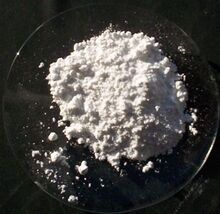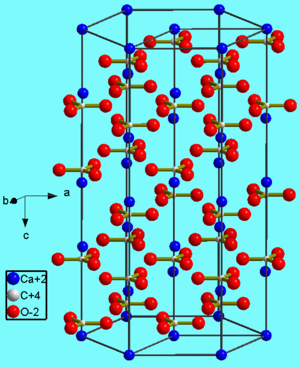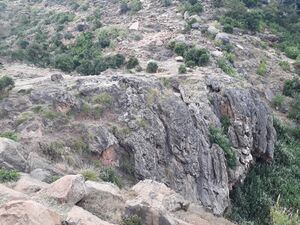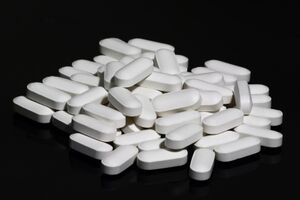كربونات الكالسيوم
| ||||||||||||||||||||||||||||||||||||||||||||||||||||||||||||||||||||||||||||||||||||||||||||||||||||||||||||||||||||
كربونات الكالسيوم Calcium carbonate هي مركب كيميائي, صيغته الكيميائية CaCO3. وهي مادة شائعة تتواجد في شكل صخر في جميع أنجاء العالم، هي المكون الرئيسي في أصداف الكائنات البحرية والحلزونات وقشر البيض. وكربونات الكالسيوم هي المكون الفعال في الجير الزراعي, وعادة ما تكون السبب الرئيسي للماء العسر. ويشيع استعمالها طبياً كجرعة اضافية من الكالسيوم أو كمضاد للحموضة.
كربونات الكالسيوم معدن بلوري أبيض. الصيغة الكيميائية لكربونات الكالسيوم هي (CaCO3)، وهو موجود على نطاق واسع في الطبيعة،كما أنه المكوّن الرئيسي للحجر الجيري، والرخام والمرجان والكلسيت والطباشير. وفي المغاور (الكهوف) تعمل المياه الجوفية على ترسيب كربونات الكالسيوم خلال فترة زمنية لتشكيل الترسبات الكلسية في أرض المغاور، والترسبات الكلسية التي تتدلي من أسقفها. وتدخل كربونات الكالسيوم في تركيب معاجين الأسنان ومساحيقها، وتستعمل أيضاً في بعض الأدوية لتخفيض الحموضة في المعدة.
كربونات الكالسيوم شحيحة الذوبان في الماء النقي، ولكنها تكون بيكربونات الكالسيوم، في وجود ثاني أكسيد الكربون.
. . . . . . . . . . . . . . . . . . . . . . . . . . . . . . . . . . . . . . . . . . . . . . . . . . . . . . . . . . . . . . . . . . . . . . . . . . . . . . . . . . . . . . . . . . . . . . . . . . . . . . . . . . . . . . . . . . . . . . . . . . . . . . . . . . . . . . . . . . . . . . . . . . . . . . . . . . . . . . . . . . . . . . . .
الكيمياء
Calcium carbonate shares the typical properties of other carbonates. Notably it
- reacts with acids, releasing carbon dioxide (technically speaking, carbonic acid, but that disintegrates quickly to CO2 and H2O):
- CaCO3(s) + 2 H+(aq) → Ca2+(aq) + CO2(g) + H2O(l)
- releases carbon dioxide upon heating, called a thermal decomposition reaction, or calcination (to above 840 °C in the case of CaCO3), to form calcium oxide, commonly called quicklime, with reaction enthalpy 178 kJ/mol:
- CaCO3(s) → CaO(s) + CO2(g)
Calcium carbonate will react with water that is saturated with carbon dioxide to form the soluble calcium bicarbonate.
- CaCO3(s) + CO2(g) + H2O(l) → Ca(HCO3)2(aq)
This reaction is important in the erosion of carbonate rock, forming caverns, and leads to hard water in many regions.
An unusual form of calcium carbonate is the hexahydrate, ikaite, CaCO3·6H2O. Ikaite is stable only below 8 °C.
الإعداد
- CaCO3 → CaO + CO2
- CaO + H2O → Ca(OH)2
- Ca(OH)2 + CO2 → CaCO3 + H2O
قابلية الذوبان
مع ضغط CO2 متغير
| قابلية أيون الكالسيوم للذوبان كدالة في CO2 ضغط جزئي عند 25 °س | ||
|---|---|---|
| (ض.ج.) | pH | [Ca2+] (mol/L) |
| 10−12 | 12.0 | 5.19 × 10−3 |
| 10−10 | 11.3 | 1.12 × 10−3 |
| 10−8 | 10.7 | 2.55 × 10−4 |
| 10−6 | 9.83 | 1.20 × 10−4 |
| 10−4 | 8.62 | 3.16 × 10−4 |
| 3.5 × 10−4 | 8.27 | 4.70 × 10−4 |
| 10−3 | 7.96 | 6.62 × 10−4 |
| 10−2 | 7.30 | 1.42 × 10−3 |
| 10−1 | 6.63 | 3.05 × 10−3 |
| 1 | 5.96 | 6.58 × 10−3 |
| 10 | 5.30 | 1.42 × 10−2 |
غالباً ما تكون كربونات الكاسيوم ضعيفة الانحلال في الماء النقي، ومعادلة انحلالها هي (كربونات الكالسيوم المنحلة موجودة على اليمين):
CaCO3 ⇋ Ca2+ + CO32– Ksp = 3.7×10–9 to 8.7×10–9 at 25 °س
التواجد
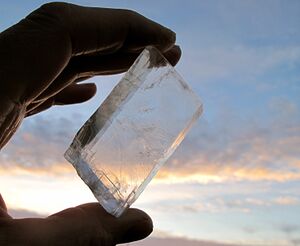
المصادر الجيولوجية
Calcite, aragonite and vaterite are pure calcium carbonate minerals. Industrially important source rocks which are predominantly calcium carbonate include limestone, chalk, marble and travertine.
المصادر الحيوية
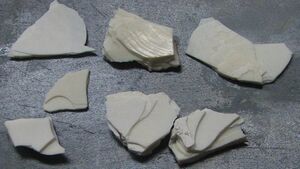
Eggshells, snail shells and most seashells are predominantly calcium carbonate and can be used as industrial sources of that chemical.[7] Oyster shells have enjoyed recent recognition as a source of dietary calcium, but are also a practical industrial source.[8][9] Dark green vegetables such as broccoli and kale contain dietarily significant amounts of calcium carbonate, however, they are not practical as an industrial source.[10]
خارج كوكب الأرض
Beyond Earth, strong evidence suggests the presence of calcium carbonate on Mars. Signs of calcium carbonate have been detected at more than one location (notably at Gusev and Huygens craters). This provides some evidence for the past presence of liquid water.[11][12]
الجيولوجيا
Carbonate is found frequently in geologic settings and constitutes an enormous carbon reservoir. Calcium carbonate occurs as aragonite, calcite and dolomite as significant constituents of the calcium cycle. The carbonate minerals form the rock types: limestone, chalk, marble, travertine, tufa, and others.
In warm, clear tropical waters corals are more abundant than towards the poles where the waters are cold. Calcium carbonate contributors, including plankton (such as coccoliths and planktic foraminifera), coralline algae, sponges, brachiopods, echinoderms, bryozoa and mollusks, are typically found in shallow water environments where sunlight and filterable food are more abundant. Cold-water carbonates do exist at higher latitudes but have a very slow growth rate. The calcification processes are changed by ocean acidification.
Where the oceanic crust is subducted under a continental plate sediments will be carried down to warmer zones in the asthenosphere and lithosphere. Under these conditions calcium carbonate decomposes to produce carbon dioxide which, along with other gases, give rise to explosive volcanic eruptions.
عمق تعويض الكربونات
The carbonate compensation depth (CCD) is the point in the ocean where the rate of precipitation of calcium carbonate is balanced by the rate of dissolution due to the conditions present. Deep in the ocean, the temperature drops and pressure increases. Calcium carbonate is unusual in that its solubility increases with decreasing temperature.[13] Increasing pressure also increases the solubility of calcium carbonate. The carbonate compensation depth can range from 4,000 to 6,000 meters below sea level.
Role in taphonomy
Calcium carbonate can preserve fossils through permineralization. Most of the vertebrate fossils of the Two Medicine Formation—a geologic formation known for its duck-billed dinosaur eggs—are preserved by CaCO3 permineralization.[14] This type of preservation conserves high levels of detail, even down to the microscopic level. However, it also leaves specimens vulnerable to weathering when exposed to the surface.[14]
Trilobite populations were once thought to have composed the majority of aquatic life during the Cambrian, due to the fact that their calcium carbonate-rich shells were more easily preserved than those of other species,[15] which had purely chitinous shells.
. . . . . . . . . . . . . . . . . . . . . . . . . . . . . . . . . . . . . . . . . . . . . . . . . . . . . . . . . . . . . . . . . . . . . . . . . . . . . . . . . . . . . . . . . . . . . . . . . . . . . . . . . . . . . . . . . . . . . . . . . . . . . . . . . . . . . . . . . . . . . . . . . . . . . . . . . . . . . . . . . . . . . . . .
الاستخدامات
التطبيقات الصناعية
The main use of calcium carbonate is in the construction industry, either as a building material, or limestone aggregate for road building, as an ingredient of cement, or as the starting material for the preparation of builders' lime by burning in a kiln. However, because of weathering mainly caused by acid rain,[16] calcium carbonate (in limestone form) is no longer used for building purposes on its own, but only as a raw primary substance for building materials.
Calcium carbonate is also used in the purification of iron from iron ore in a blast furnace. The carbonate is calcined in situ to give calcium oxide, which forms a slag with various impurities present, and separates from the purified iron.[17]
In the oil industry, calcium carbonate is added to drilling fluids as a formation-bridging and filtercake-sealing agent; it is also a weighting material which increases the density of drilling fluids to control the downhole pressure. Calcium carbonate is added to swimming pools, as a pH corrector for maintaining alkalinity and offsetting the acidic properties of the disinfectant agent.[18]
It is also used as a raw material in the refining of sugar from sugar beet; it is calcined in a kiln with anthracite to produce calcium oxide and carbon dioxide. This burnt lime is then slaked in fresh water to produce a calcium hydroxide suspension for the precipitation of impurities in raw juice during carbonatation.[19]
Calcium carbonate in the form of chalk has traditionally been a major component of blackboard chalk. However, modern manufactured chalk is mostly gypsum, hydrated calcium sulfate CaSO4·2H2O. Calcium carbonate is a main source for growing Seacrete. Precipitated calcium carbonate (PCC), pre-dispersed in slurry form, is a common filler material for latex gloves with the aim of achieving maximum saving in material and production costs.[20]
Fine ground calcium carbonate (GCC) is an essential ingredient in the microporous film used in diapers and some building films, as the pores are nucleated around the calcium carbonate particles during the manufacture of the film by biaxial stretching. GCC and PCC are used as a filler in paper because they are cheaper than wood fiber. In terms of market volume, GCC are the most important types of fillers currently used.[21] Printing and writing paper can contain 10–20% calcium carbonate. In North America, calcium carbonate has begun to replace kaolin in the production of glossy paper. Europe has been practicing this as alkaline papermaking or acid-free papermaking for some decades. PCC used for paper filling and paper coatings is precipitated and prepared in a variety of shapes and sizes having characteristic narrow particle size distributions and equivalent spherical diameters of 0.4 to 3 micrometers.[بحاجة لمصدر]
Calcium carbonate is widely used as an extender in paints,[22] in particular matte emulsion paint where typically 30% by weight of the paint is either chalk or marble. It is also a popular filler in plastics.[22] Some typical examples include around 15 to 20% loading of chalk in unplasticized polyvinyl chloride (uPVC) drainpipes, 5% to 15% loading of stearate-coated chalk or marble in uPVC window profile. PVC cables can use calcium carbonate at loadings of up to 70 phr (parts per hundred parts of resin) to improve mechanical properties (tensile strength and elongation) and electrical properties (volume resistivity).[بحاجة لمصدر] Polypropylene compounds are often filled with calcium carbonate to increase rigidity, a requirement that becomes important at high usage temperatures.[23] Here the percentage is often 20–40%. It also routinely used as a filler in thermosetting resins (sheet and bulk molding compounds)[23] and has also been mixed with ABS, and other ingredients, to form some types of compression molded "clay" poker chips.[24] Precipitated calcium carbonate, made by dropping calcium oxide into water, is used by itself or with additives as a white paint, known as whitewashing.[25][26]
Calcium carbonate is added to a wide range of trade and do it yourself adhesives, sealants, and decorating fillers.[22] Ceramic tile adhesives typically contain 70% to 80% limestone. Decorating crack fillers contain similar levels of marble or dolomite. It is also mixed with putty in setting stained glass windows, and as a resist to prevent glass from sticking to kiln shelves when firing glazes and paints at high temperature.[بحاجة لمصدر]
In ceramic glaze applications, calcium carbonate is known as whiting,[22] and is a common ingredient for many glazes in its white powdered form. When a glaze containing this material is fired in a kiln, the whiting acts as a flux material in the glaze. Ground calcium carbonate is an abrasive (both as scouring powder and as an ingredient of household scouring creams), in particular in its calcite form, which has the relatively low hardness level of 3 on the Mohs scale, and will therefore not scratch glass and most other ceramics, enamel, bronze, iron, and steel, and have a moderate effect on softer metals like aluminium and copper. A paste made from calcium carbonate and deionized water can be used to clean tarnish on silver.[27]
التطبيقات الصحية والغذائية
Calcium carbonate is widely used medicinally as an inexpensive dietary calcium supplement for gastric antacid[28] (such as Tums). It may be used as a phosphate binder for the treatment of hyperphosphatemia (primarily in patients with chronic kidney failure). It is used in the pharmaceutical industry as an inert filler for tablets and other pharmaceuticals.[29]
Calcium carbonate is used in the production of calcium oxide as well as toothpaste and has seen a resurgence as a food preservative and color retainer, when used in or with products such as organic apples.[30]
Calcium carbonate is used therapeutically as phosphate binder in patients on maintenance haemodialysis. It is the most common form of phosphate binder prescribed, particularly in non-dialysis chronic kidney disease. Calcium carbonate is the most commonly used phosphate binder, but clinicians are increasingly prescribing the more expensive, non-calcium-based phosphate binders, particularly sevelamer.
Excess calcium from supplements, fortified food, and high-calcium diets can cause milk-alkali syndrome, which has serious toxicity and can be fatal. In 1915, Bertram Sippy introduced the "Sippy regimen" of hourly ingestion of milk and cream, and the gradual addition of eggs and cooked cereal, for 10 days, combined with alkaline powders, which provided symptomatic relief for peptic ulcer disease. Over the next several decades, the Sippy regimen resulted in kidney failure, alkalosis, and hypercalcaemia, mostly in men with peptic ulcer disease. These adverse effects were reversed when the regimen stopped, but it was fatal in some patients with protracted vomiting. Milk-alkali syndrome declined in men after effective treatments for peptic ulcer disease arose. Since the 1990s it has been most frequently reported in women taking calcium supplements above the recommended range of 1.2 to 1.5 grams daily, for prevention and treatment of osteoporosis,[31][32] and is exacerbated by dehydration. Calcium has been added to over-the-counter products, which contributes to inadvertent excessive intake. Excessive calcium intake can lead to hypercalcemia, complications of which include vomiting, abdominal pain and altered mental status.[33]
As a food additive it is designated E170,[34] and it has an INS number of 170. Used as an acidity regulator, anticaking agent, stabilizer or color it is approved for usage in the EU,[35] USA[36] and Australia and New Zealand.[37] It is used in some soy milk and almond milk products as a source of dietary calcium; one study suggests that calcium carbonate might be as bioavailable as the calcium in cow's milk.[38] Calcium carbonate is also used as a firming agent in many canned and bottled vegetable products.
الاستخدام الزراعي
Agricultural lime, powdered chalk or limestone, is used as a cheap method for neutralising acidic soil, making it suitable for planting.[39]
الاستخدام المنزلي
Calcium carbonate is a key ingredient in many household cleaning powders like Comet and is used as a scrubbing agent.
الاستخدامات البيئية
In 1989, a researcher, Ken Simmons, introduced CaCO3 into the Whetstone Brook in Massachusetts.[40] His hope was that the calcium carbonate would counter the acid in the stream from acid rain and save the trout that had ceased to spawn. Although his experiment was a success, it did increase the amount of aluminium ions in the area of the brook that was not treated with the limestone. This shows that CaCO3 can be added to neutralize the effects of acid rain in river ecosystems. Currently calcium carbonate is used to neutralize acidic conditions in both soil and water.[41][42][43] Since the 1970s, such liming has been practiced on a large scale in Sweden to mitigate acidification and several thousand lakes and streams are limed repeatedly.[44]
Calcium carbonate is also used in flue gas desulfurisation applications eliminating harmful SO2 and NO2 emissions from coal and other fossil fuels burnt in large fossil fuel power stations.[41]
. . . . . . . . . . . . . . . . . . . . . . . . . . . . . . . . . . . . . . . . . . . . . . . . . . . . . . . . . . . . . . . . . . . . . . . . . . . . . . . . . . . . . . . . . . . . . . . . . . . . . . . . . . . . . . . . . . . . . . . . . . . . . . . . . . . . . . . . . . . . . . . . . . . . . . . . . . . . . . . . . . . . . . . .
اتزان التكليس
Calcination of limestone using charcoal fires to produce quicklime has been practiced since antiquity by cultures all over the world. The temperature at which limestone yields calcium oxide is usually given as 825 °C, but stating an absolute threshold is misleading. Calcium carbonate exists in equilibrium with calcium oxide and carbon dioxide at any temperature. At each temperature there is a partial pressure of carbon dioxide that is in equilibrium with calcium carbonate. At room temperature the equilibrium overwhelmingly favors calcium carbonate, because the equilibrium CO2 pressure is only a tiny fraction of the partial CO2 pressure in air, which is about 0.035 kPa.
At temperatures above 550 °C the equilibrium CO2 pressure begins to exceed the CO2 pressure in air. So above 550 °C, calcium carbonate begins to outgas CO2 into air. However, in a charcoal fired kiln, the concentration of CO2 will be much higher than it is in air. Indeed, if all the oxygen in the kiln is consumed in the fire, then the partial pressure of CO2 in the kiln can be as high as 20 kPa.[45]
The table shows that this partial pressure is not achieved until the temperature is nearly 800 °C. For the outgassing of CO2 from calcium carbonate to happen at an economically useful rate, the equilibrium pressure must significantly exceed the ambient pressure of CO2. And for it to happen rapidly, the equilibrium pressure must exceed total atmospheric pressure of 101 kPa, which happens at 898 °C.
| ضغط الاتزان للـ CO2 فوق CaCO3[46] | |
|---|---|
| 550 °س | 0.055 كيلو پا |
| 587 °س | 0.13 كيلو پا |
| 605 °س | 0.31 كيلو پا |
| 680 °س | 1.80 كيلو پا |
| 727 °س | 5.9 كيلو پا |
| 748 °س | 9.3 كيلو پا |
| 777 °س | 14 كيلو پا |
| 800 °س | 24 كيلو پا |
| 830 °س | 34 كيلو پا |
| 852 °س | 51 كيلو پا |
| 871 °س | 72 كيلو پا |
| 881 °س | 80 كيلو پا |
| 891 °س | 91 كيلو پا |
| 898 °س | 101 كيلو پا |
| 937 °س | 179 كيلو پا |
| 1082 °س | 901 كيلو پا |
| 1241 °س | 3961 كيلو پا |
صيدلانياً
الفئة الوظيفية
عامل دارئ buffering agent، عامل تلبيس coating agent، مادة معتمة opacifier، عامل ممدد للمضغوطات والكبسولات، ومادة علاجية.[47]
تطبيقاته في الصيغ الصيدلانية
يعتبر كربونات الكالسيوم كسواغ صيدلاني ويستعمل بشكل أساسي كممدد في الأشكال الجرعية الصلبة. كما يستعمل كأساس في المستحضرات السنية وكعامل دارئ ومساعد على الذوبان في المضغوطات. يستعمل كربونات الكالسيوم كعامل مالئ في عمليات التلبيس السكري للمضغوطات وكعامل معتم في المضغوطات الملبسة بالفيلم. كما يستعمل كمضافات غذائية علاجية وكمادة مضادة للحموضة.
الوصف
مسحوق أبيض أو بلوري. عديم اللون وعديم الطعم .[48]
الانحلالية
ينحل في الكحول (95%). وتزداد انحلاليته في الماء بوجود أملاح الامونيوم أو ثنائي أكسيد الكربون. ويقلل من انحلاليته وجود الهيدروكسيدات القلوية.[49]
شروط الحفظ والثباتية
يعبأ في أوعية جيدة الإحكام وبمكان بارد وجاف.[50]
التنافرات
يتنافر مع الحموض وأملاح الأمونيوم.
مأمونية الاستخدام
يستعمل كربونات الكالسيوم بشكل رئيسي بالصيغ الفموية ويعتبر مادة غير سامة عموماً. لكن قد يسبب كربونات الكالسيوم المتناول فموياً الإمساك constipation والتطبّل flatulence. ويسبب تناول كميات كبيرة من كربونات الكالسيوم (4 – 60) غ/ اليوم فرط بكالسيوم الدم hupercalcemia أو خلل مشاكل كلوية. علاجياً، تستعمل الجرعات الفموية حتى 1.5 غ كمادة مضادة للحموضة. ويستخدم بجرعة 2.5 – 17 غ في علاج فرط فوسفاتاز الدم لدى مرضى الفشل الكلوي المزمن. قد يتداخل كربونات الكالسيوم مع امتصاص الأدوية بالجهاز الهضمي إن تم تناولهما معاً.[51]
التعقيبات
عندما تستخدم كربونات الكالسيوم في المضغوطات المحتوية على الأسبرين قد يتغير لونها بسبب وجود آثار من الحديد. ويمكن التغلب على ذلك بوضع مادة خالبة ضمنها chelating agent. تتوفر تجارياً العديد من السواغات الحاوية على كربونات الكالسيوم وغيرها من السواغات الممددة للمضغوطات بطريقة الضغط المباشر.
انظر أيضاً
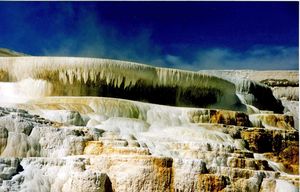
- احمضاض المحيط
- Gesso
- Cuttlefish
- Cuttlebone
- رخام الاستخدام الصناعي للرخام (المطحون)
- كلسيت
- طباشير
- ملح كيميائي
المصادر
- ^ Benjamin, Mark M. (2002). Water Chemistry. McGraw-Hill. ISBN 978-0-07-238390-4.
- ^ Aylward, Gordon; Findlay, Tristan (2008). SI Chemical Data Book (4th ed.). John Wiley & Sons Australia. ISBN 978-0-470-81638-7.
- ^ Rohleder, J.; Kroker, E. (2001). Calcium Carbonate: From the Cretaceous Period Into the 21st Century. Springer Science & Business Media. ISBN 978-3-7643-6425-0.
- ^ أ ب Zumdahl, Steven S. (2009). Chemical Principles 6th Ed. Houghton Mifflin Company. p. A21. ISBN 978-0-618-94690-7.
- ^ NIOSH Pocket Guide to Chemical Hazards 0090
- ^ Russell, Daniel E . 17 February 2008. Retrieved December 31, 2010. "Helgustadir Iceland Spar Mine" mindat.org
- ^ Horne, Francis (23 October 2006). "How are seashells created?". Scientific American. Retrieved 25 April 2012.
- ^ "Oyster shell calcium". WebMD. Retrieved 25 April 2012.
- ^ "Oyster Shell Calcium Carbonate". Caltron Clays & Chemicals. Archived from the original on 10 September 2013. Retrieved 25 April 2012.
- ^ Mangels, Ann Reed (June 4, 2014). "Bone nutrients for vegetarians". The American Journal of Clinical Nutrition. 100 (1): 469S–475S. doi:10.3945/ajcn.113.071423. PMID 24898231.
{{cite journal}}: CS1 maint: date and year (link) - ^ Boynton, W. V.; Ming, D. W.; Kounaves, S. P.; et al. (2009). "Evidence for Calcium Carbonate at the Mars Phoenix Landing Site" (PDF). Science. 325 (5936): 61–64. Bibcode:2009Sci...325...61B. doi:10.1126/science.1172768. PMID 19574384. S2CID 26740165.
- ^
Clark, B. C., III; Arvidson, R. E.; Gellert, R.; et al. (2007). "Evidence for montmorillonite or its compositional equivalent in Columbia Hills, Mars" (PDF). Journal of Geophysical Research. 112 (E6): E06S01. Bibcode:2007JGRE..112.6S01C. doi:10.1029/2006JE002756. hdl:1893/17119.
{{cite journal}}: CS1 maint: multiple names: authors list (link) - ^ Weyl, P.K. (1959). "The change in solubility of calcium carbonate with temperature and carbon dioxide content". Geochimica et Cosmochimica Acta. 17 (3–4): 214–225. Bibcode:1959GeCoA..17..214W. doi:10.1016/0016-7037(59)90096-1.
- ^ أ ب Trexler, D. (2001). "Two Medicine Formation, Montana: geology and fauna". In Tanke, D. H.; Carpenter, K. (eds.). Mesozoic Vertebrate Life. Indiana University Press. pp. 298–309. ISBN 978-0-253-33907-2.
- ^ Ward, Peter (2006). Out of Thin Air: Dinosaurs, Birds, and Earth's Ancient Atmosphere (in الإنجليزية). doi:10.17226/11630. ISBN 9780309666121.
- ^ "Effects of Acid Rain". US Environmental Protection Agency. Retrieved 14 March 2015.
- ^ "Blast Furnace". Science Aid. Archived from the original on 17 December 2007. Retrieved 30 December 2007.
- ^ Sfetcu, Nicolae (2014-05-02). Health & Drugs: Disease, Prescription & Medication (in الإنجليزية). Nicolae Sfetcu.
- ^ McGinnis, R. A. Beet-Sugar Technology (2nd ed.). Beet Sugar Development Foundation. p. 178.
- ^ "Precipitated Calcium Carbonate uses". Archived from the original on 25 July 2014.
- ^ "Market Study Fillers, 2nd ed". Ceresana. September 2011.
- ^ أ ب ت ث "Calcium Carbonate Powder". Reade Advanced Materials. 4 February 2006. Archived from the original on 22 February 2008. Retrieved 30 December 2007.
- ^ أ ب "Calcium carbonate in plastic applications". Imerys Performance Minerals. Archived from the original on 4 August 2008. Retrieved 1 August 2008.
- ^ "Why do calcium carbonate play an important part in Industrial". www.xintuchemical.com (in الإنجليزية). Retrieved 2018-10-07.
- ^ "precipitated calcium carbonate commodity price". www.dgci.be. Archived from the original on 7 October 2018. Retrieved 2018-10-07.
- ^ Jimoh, O.A.; et al. (2017). "Understanding the Precipitated Calcium Carbonate (PCC) Production Mechanism and Its Characteristics in the Liquid–Gas System Using Milk of Lime (MOL) Suspension" (PDF). South African Journal of Chemistry. 70: 1–7. doi:10.17159/0379-4350/2017/v70a1.
- ^ "Ohio Historical Society Blog: Make It Shine". Ohio Historical Society. Archived from the original on 23 March 2012. Retrieved 2 June 2011.
- ^ "Calcium Carbonate". Medline Plus. National Institutes of Health. 1 October 2005. Archived from the original on 17 October 2007. Retrieved 30 December 2007.
- ^ Lieberman, Herbert A.; Lachman, Leon; Schwartz, Joseph B. (1990). Pharmaceutical Dosage Forms: Tablets. New York: Dekker. p. 153. ISBN 978-0-8247-8044-9.
- ^ "Food Additives – Names Starting with C". Chemistry.about.com. 10 April 2012. Archived from the original on 16 October 2006. Retrieved 2012-05-24.
- ^ Caruso JB, Patel RM, Julka K, Parish DC (July 2007). "Health-behavior induced disease: return of the milk-alkali syndrome". J Gen Intern Med. 22 (7): 1053–5. doi:10.1007/s11606-007-0226-0. PMC 2219730. PMID 17483976.
- ^ Beall DP, Henslee HB, Webb HR, Scofield RH (May 2006). "Milk-alkali syndrome: a historical review and description of the modern version of the syndrome". Am. J. Med. Sci. 331 (5): 233–42. doi:10.1097/00000441-200605000-00001. PMID 16702792. S2CID 45802184.
- ^ Gabriely, Ilan; Leu, James P.; Barzel, Uriel S. (2008). "Clinical problem-solving, back to basics". New England Journal of Medicine. 358 (18): 1952–6. doi:10.1056/NEJMcps0706188. PMID 18450607.
- ^ "E-numbers: E170 Calcium carbonate". Food-Info.net. 080419 food-info.net
- ^ "Current EU approved additives and their E Numbers". UK Food Standards Agency. Retrieved 27 October 2011.
- ^ "Listing of Food Additives Status Part I". US Food and Drug Administration. Archived from the original on 14 March 2013. Retrieved 27 October 2011.
- ^ "Standard 1.2.4 – Labelling of ingredients". Australia New Zealand Food Standards Code. Retrieved 27 October 2011.
- ^ Zhao, Y.; Martin, B. R.; Weaver, C. M. (2005). "Calcium bioavailability of calcium carbonate fortified soymilk is equivalent to cow's milk in young women". The Journal of Nutrition. 135 (10): 2379–2382. doi:10.1093/jn/135.10.2379. PMID 16177199.
- ^ Oates, J. A. H. (11 July 2008). Lime and Limestone: Chemistry and Technology, Production and Uses. John Wiley & Sons. pp. 111–113. ISBN 978-3-527-61201-7.
- ^ "Limestone Dispenser Fights Acid Rain in Stream". The New York Times. Associated Press. 13 June 1989.
- ^ أ ب "Environmental Uses for Calcium Carbonate". Congcal. Retrieved 5 August 2013.
- ^ Schreiber, R. K. (1988). "Cooperative federal-state liming research on surface waters impacted by acidic deposition". Water, Air, & Soil Pollution. 41 (1): 53–73. doi:10.1007/BF00160344 (inactive 30 October 2020).
{{cite journal}}: CS1 maint: DOI inactive as of أكتوبر 2020 (link) - ^ Kircheis, Dan; Dill, Richard (2006). "Effects of low pH and high aluminum on Atlantic salmon smolts in Eastern Maine and liming project feasibility analysis" (reprinted at Downeast Salmon Federation). National Marine Fisheries Service and Maine Atlantic Salmon Commission.[dead link]
- ^ Guhrén, M.; Bigler, C.; Renberg, I. (2006). "Liming placed in a long-term perspective: A paleolimnological study of 12 lakes in the Swedish liming program". Journal of Paleolimnology. 37 (2): 247–258. Bibcode:2007JPall..37..247G. doi:10.1007/s10933-006-9014-9. S2CID 129439066.
- ^ "Solvay Precipitated Calcium Carbonate: Production". Solvay. 9 March 2007. Retrieved 30 December 2007.
- ^ CRC Handbook of Chemistry and Physics 44th ed.
- ^ Handbook of Pharmaceutical Excipients
- ^ BP: British Pharmacopiea
- ^ BP: British Pharmacopiea
- ^ BP: British Pharmacopiea
- ^ Martindal
وصلات خارجية
قالب:Drugs for treatment of hyperkalemia and hyperphosphatemia
- CS1 maint: date and year
- CS1 maint: DOI inactive as of أكتوبر 2020
- Articles with dead external links from June 2019
- Short description is different from Wikidata
- Articles with changed EBI identifier
- ECHA InfoCard ID from Wikidata
- E number from Wikidata
- Articles containing unverified chemical infoboxes
- Articles with unsourced statements from June 2015
- جداول تصفح صيدلة
- صيدلة
- مركبات غير عضوية
- مركبات الكالسيوم
- كربونات
- حجر جيري
- Phosphate binders
- سواغات
- مضادات الحموضة
- Food stabilizers
- مضافات غذائية بأرقام أوروپية



